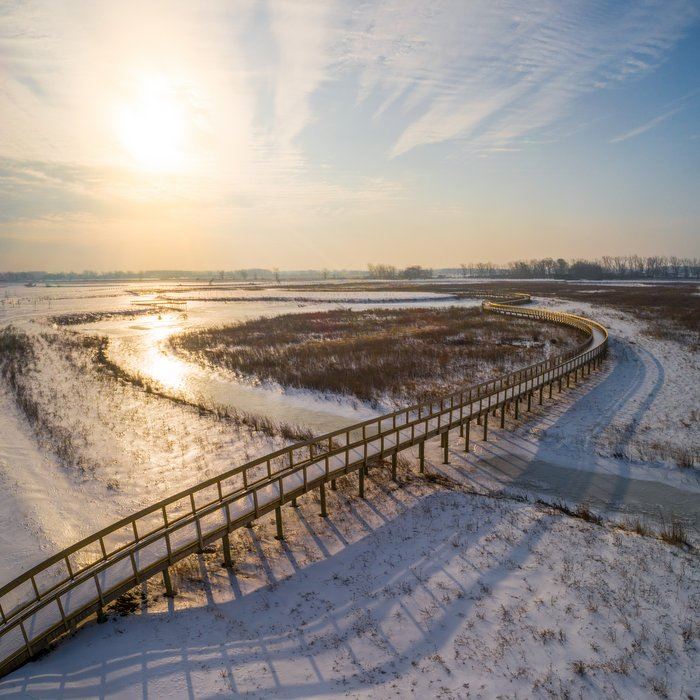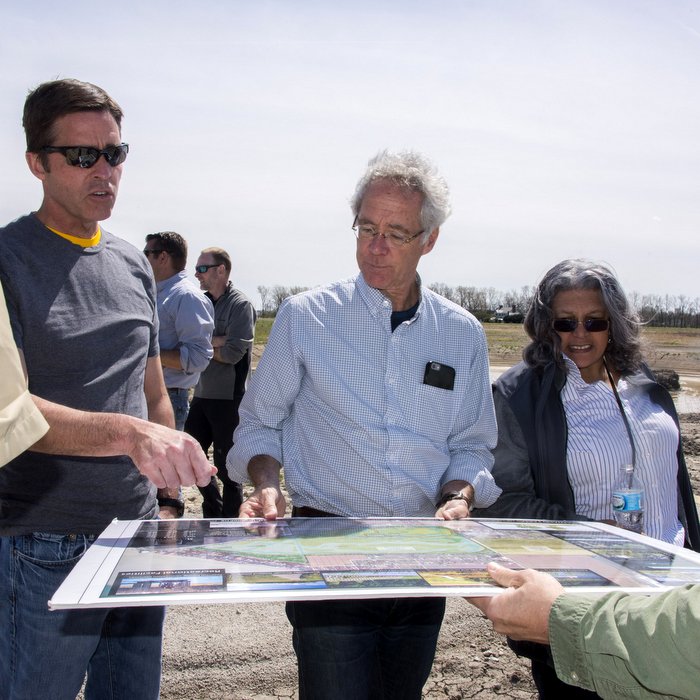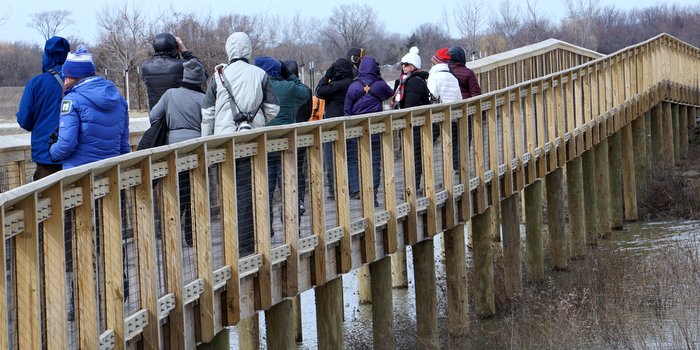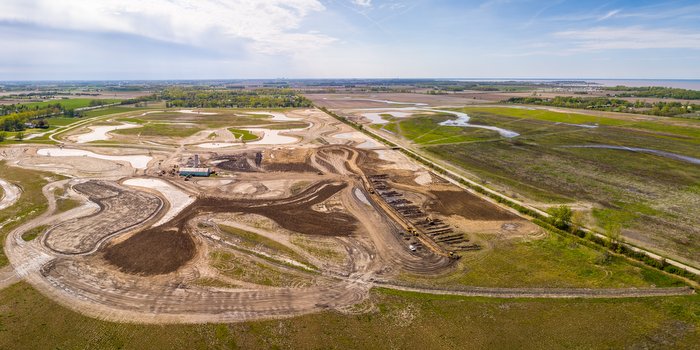A Marsh & More: New Park Advances Many Goals

A new park near the Lake Erie shore will expand fishing, birding and paddling opportunities in a region of Ohio where outdoor enthusiasts celebrate spring holidays with walleye, warblers and watercraft. The biggest beneficiary of all, however, may be the lake itself.
When Howard Marsh Metropark opens in late April, it will also put Metroparks Toledo a step closer to fulfilling its promise of a park within five miles of every home in the county.
While Western Lake Erie is an international destination for birding, fishing and boating, it has also made national news in recent years because of water quality issues. Dave Zenk, executive director of Metroparks Toledo, said Howard Marsh will help restore the lake and, with it, the region’s reputation. “This area is an outdoors lover’s paradise with world class natural features, yet as far as we’ve come, we still have room for improvement,” he said.
Metroparks established its first park on the river’s edge nearly 90 years ago, and today has five parks overlooking the water. Howard Marsh is the 16th park in the 12,000-acre park system, and the closest to the lake.
“It is the largest project we’ve ever undertaken, one of our most important projects from an ecological standpoint, and extremely timely for our region given the recent troubles we’ve experienced with Lake Erie,” Zenk said.
Just six months ago, blue-green algae oozed into a kayak cove at Middlegrounds Metropark in downtown Toledo. It wasn’t the first time the iridescent slime had plagued the region; the potentially toxic algae made national headlines in August 2014 when it prompted the city of Toledo to issue a drinking water advisory for parts of three days.
Phosphorus run-off from agricultural lands upstream is the primary culprit of the recurring problem. The chemical element contributes to the growth of algae, which produces toxins as it decays in Lake Erie, the source of drinking water for 11 million people.
Contributing to the water quality woes is the loss of natural wetlands, which function like kidneys, filtering out excess nutrients that cause algal blooms while providing critical fish and wildlife habitat. Wetlands are among the most productive ecosystems on Earth – comparable to rain forests and coral reefs, says the U.S. Environmental Protection Agency. These systems support more than one-third of the threatened and endangered wildlife species in the United States, while providing natural water quality improvements and flood protection.
Half of the wetlands in the Great Lakes basin are gone. In western Lake Erie, where just 10 percent of the original 300,000-acres of wetland remain, every acre counts. The largest new wetland restoration project underway on the Great Lakes, Howard Marsh, will take hundreds of acres near the lakeshore – approximately 750 now and 250 in the future – from a willing landowner out of agricultural production and re-create a marsh wetland as buffer between land and lake.
“According to the scientific literature, one acre of restored Lake Erie coastal wetland can remove 13 pounds of phosphorus from the water per year,” said Tim Schetter, Ph.D., director of natural resources for Metroparks Toledo.

Photo: Metroparks Board members Scott Savage, Fritz Byers and Lera Doneghy review plans for the park during a visit to the site.
Partnerships Were Pivotal
The property, known historically as Howard Farms, is the last remaining large tract of land in the Western Lake Erie marsh region. The Ohio Department of Natural Resources Division of Wildlife has been interested in the property for more than 20 years, but was not able to come to terms with the owner.
When Metroparks successfully negotiated an agreement in 2008, the Division of Wildlife contributed half of the $6 million purchase price. Metroparks and the Division of Wildlife entered into a management agreement for fishing, hunting, trapping and wildlife recreation and conservation at the marsh. The other half of the purchase price was paid for with a $1.76 million grant from the Clean Ohio Fund Greenspace Conservation Program and $1.24 million from Metroparks.
Converting Howard Farms into Howard Marsh required additional partnerships and funding. Metroparks contracted with Ducks Unlimited, the international wetlands conservation organization, to design the wetland habitat infrastructure, and with SmithGroupJRR, of Ann Arbor, Michigan, to design the public amenities infrastructure.
The Division of Wildlife committed a total of $4 million to help fund the wetland restoration, with Metroparks providing a 25 percent match. The Division’s contribution was reimbursed with dollars from the federal Pittman-Robertson Act, an excise tax on hunting and fishing equipment used to fund habitat restoration.
Ducks Unlimited obtained a $2.8 million grant from the National Oceanic and Atmospheric Administration through the Great Lakes Restoration Initiative to assist with construction.
“Successful conservation requires multi-level private/public partnerships, as so well modeled here at Howard Marsh and elsewhere in the western basin of Lake Erie,” said Gildo Tori, director of public policy for Ducks Unlimited’s Great Lakes/Atlantic Region. “The complexities of habitat conservation in areas that have been greatly altered provide challenges that demand creative thinking, and innovative action that often requires diverse partnerships. Then there is the funding puzzle to solve as well! Using private/public partnerships to leverage and multiply different funding pots makes these mega-habitat restoration projects doable.”
A contractor, Mark Haynes Construction of Norwalk, Ohio, began work in June 2016 and finished last fall after moving enough dirt – approximately 700,000 cubic yards – to fill the first 24 floors of the Empire State Building. Nearly 30,000 tons of stone was hauled in, and before the project is done, 12,000 trees and shrubs will be planted. By opening day, the property will be mostly flooded with lake water from a channel, thanks to new pumps capable of moving 1.2 million gallons per hour. The main pump, said Schetter, could fill an Olympic-sized swimming pool in 33 minutes.
“It’s been an amazing transformation,” said Denis Franklin, a supervisor in the Metroparks natural resources department who has overseen the project from the start. “It’s hard to imagine just 18 months ago this was a farm field.”
Since construction started, Franklin said, the project has generated interest from local, state and federal agencies, as well as neighbors, nature lovers and local business groups. “We’ve given more than 70 tours since the project began,” he said. “It’s rare to see something like this, especially on this scale.”
Among the visitors was a crew from CNN, which visited the site last summer, where they interviewed Duck’s Unlimited’s Tori for a story about the potential loss of funding for the Great Lakes Restoration Initiative, an issue that has recently cropped up again.

A group of birders gets checked out the boardwalk recently to get an advance look at the new park.
More Room to Roam
Placing a park near the lakeshore has been a priority for Metroparks Toledo for years. Providing additional parkland is a strategic initiative begun in 2002 when nearly two-thirds of Lucas County electors voted in favor of a property tax levy to acquire additional parkland for the future. The “land levy” fueled the greatest era of growth in the park district’s history, leading to the opening of the first new parks in four decades.
“Since that time, we have added 4,500 acres, from the globally significant Oak Openings Region on the west side of the county, to this property near our eastern border,” said Scott J. Savage, president of the Board of Park Commissioners, governing body of Metroparks Toledo. “Without this property, we could not make good on another promise: to have a Metropark within five miles of every resident of Lucas County. With so little of the original Lake Erie wetlands remaining, being able to restore 1,000 acres so close to the shore is a rare opportunity.”
With more than six miles of hiking trails and another six miles of permanent, deep-water channel for fishing and kayaking through nearly 600 acres of marsh, the park will provide new recreational outlets while creating habitat for migrating birds and spawning fish.
“Howard Marsh will be a special place where people with varied recreational interests can enjoy the wonders of a Great Lakes coastal wetland,” said Steve Madewell, who was executive director of Metroparks Toledo when construction began, and for whom a 1,300-foot boardwalk trail there will be named. “Without a doubt, Metroparks is bringing an element to Howard Marsh that adds a wonderful dimension: excellent public access for a broad range of activities.”
Adjacent to Howard Mash is the Metzger Marsh Wildlife area. Just down the road are the Magee Marsh Wildlife Area and the Ottawa National Wildlife Refuge (Ohio’s only federal refuge). Also nearby is Maumee Bay State Park. Combined, these Lake Erie marshlands create a complex of habitat that is critically important because more than half of the endangered and threatened birds in the state require wetlands for part of their life cycle.
Birds bring birders, which is good news for local businesses, too, especially during the “shoulder seasons” in spring and fall when other forms of tourism are light. There are nearly 2.4 million birders in the state, and Ohio Sea Grant research completed in 2012 shows that bird watching along Ohio’s Lake Erie coast contributes more than $26 million annually and 283 jobs to northern Ohio’s economy.
Historically, 37 species of warblers and over 300 species of birds have been seen at Magee Marsh Wildlife Area, making it recognized worldwide as a top birding destination for songbird migration. Annually, 70,000 to 80,000 people visit Magee Marsh in the six-week period from mid-April through May during the songbird migration. The Biggest Week in American Birding, a 10-day event based at Maumee Bay State Park sponsored by the Black Swamp Bird Observatory, last year attracted visitors from 47 states and 20 countries!
Marshes are also important breeding grounds for fish in a region that calls itself the Walleye Capital of the World. Walleye fishing on Ohio’s 2.24 million acre share of Lake Erie is a $600 million a year industry.
In August, with most of the groundwork completed but the marsh not yet flooded, Metroparks invited elected officials to see the property as they would never again be able to see it. Under a large tent to fend off the cold onshore winds, local and state officials mingled with Metroparks supporters and a group of 50 visitors on a tour hosted by Ducks Unlimited.
Also in attendance was Ohio Governor John Kasich, who spoke about the recreational and tourism aspects of the project. “We need to tell the world about that,” he said. “We need to do a better job of telling people what’s here.”
For Metroparks, the economic impact on the region helps build the case for support of the agency’s conservation mission.
“More parks and trails will connect more people with the outdoors, and that’s ultimately what we are all about,” said Zenk, who has been with the park system 11 years and executive director for just over a year. “We have to keep upping our game, providing new experiences to give people reasons to keep coming back. Putting a park within only a few minutes of every single person in the district breaks down a lot of barriers and increases property values across the county.”

Photos: Aerial photos above and top show the vast park and its proximity to Lake Erie.
Note: A version of this story was published in the April 2018 issue of Parks and Recreation, the magazine of the National Recreation and Park Association.